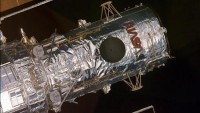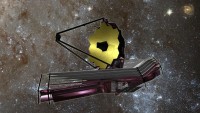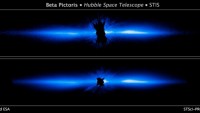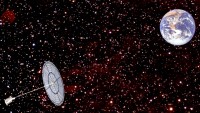Telescopes for Distant Matter and Antimatter Galaxies
| Eana Maniebo | | Aug 26, 2015 12:47 PM EDT |
(Photo : Getty Images) An engineer calibrates a laser measurement instrument before he takes measurements on the graphite super structures of the science module section of the James Webb Space Telescope at Alliant Techsystems Inc.'s (ATK) Space Components Division in Magna, Utah, U.S
The James Webb Space Telescope (JWST), which is capable of looking back 13.5 billion years to see the light created by stars from the Early Universe, is undeniably one of the most popular space exploration "ideas" in the world today. It has generated so much interest among scientists and ordinary space enthusiasts alike to a point that independent groups are willing to do everything to make a version of it in their own way.
Like Us on Facebook
And now, the telescope that has long stuck as a dream and was seen only through an artist's perspective will soon be a tangible machine. Last July, the people behind the James Webb Project announced that the long wait will soon be over, and the concept is fast approaching reality.
"Up to this point, for as long as we've been working on Webb, you've only ever really seen a cartoon of the telescope. Towards the end of this year, you will actually be able to see the James Webb Space Telescope realized in hardware," Eric Smith, James Webb Project program director and scientist, told BBC.
The telescope is now being constructed at a facility in Los Angeles and, after its completion, will be shipped to NASA's Goddard center somewhere outside Washington DC to commence the integration tasks.
The JWST is capable of capturing light emitted by stars and galaxies through a mirror with a diameter of 6.5 m, which will direct the captured images of light to four infrared instruments. The telescope and the instruments, both maintained at temperatures around or lower than -233 °C, will play a big role in detecting stars and galaxies outside the Milky Way.
"Engineers have designed a foldable mirror composed of 18 hexagonal-shaped segments constructed from beryllium, a lightweight yet strong metal. Each segment will be coated with a thin layer of gold, which is an excellent material for reflecting infrared light, protected by a thin layer of glass. The amount of gold needed for all of the JWST mirrors is equivalent in a size to a golf ball. This image shows two polished test mirror segments being inspected by an optical engineer: one segment with the gold coating already applied, the other without. In the meantime, the coating of all 18 mirrors has been completed," said a report on Phys.org.
However, the JWST isn't the only advanced technology that is shaking the world of astronomy today.
Last month, the technology innovator behind the revolutionary earth-friendly fossil fuel/coal combustion technology Thunder Energies Corporation (OTCQB: TNRG) announced that its Santilli Telescope can now be used by giant and independent space explorers as it would soon be available for sale through private distributions across the globe.
"I am particularly glad that Thunder Energies Corporation is making available to professional as well as amateur astronomers all over the world our new telescopes for the first known systematic search of antimatter galaxies following a number of scientific publications," Dr. R. M. Santilli, chief scientist of Thunder Energies, said in a press release.
The telescope, which is capable of capturing antimatter galaxies, antimatter cosmic rays, and antimatter asteroids, uses concave lenses when focusing on images of antimatter-light and a convex lenses similar to those of Galilean telescopes when focusing on images of matter-light.
"In searching for antimatter galaxies, it is of importance to note that when in contact, matter and antimatter annihilate into light. Hence, all features for capturing matter are reversed for capturing antimatter, including the index of refraction which is positive for matter-light, thus requiring a convex lens to focus images, but expected to be negative for antimatter-light, thus requiring a concave lens to focus images," the company said in a statement.
The Santilli telescope is the first optical instrument for space exploration that is capable of detecting antimatters, which "verity" remains hitherto undisclosed and a favorite subject of scientific debates.
TagsJames Webb Space Telescope, Antimatter, antimatter studies, space exploration, hubble telescope, NASA, telescopes, james webb space telescope launch date, Thunder Energies, Santilli telescope, Ruggero Santilli, antimatter galaxies, james webb space telescope news
©2015 Chinatopix All rights reserved. Do not reproduce without permission
EDITOR'S PICKS
-

Did the Trump administration just announce plans for a trade war with ‘hostile’ China and Russia?
-

US Senate passes Taiwan travel bill slammed by China
-

As Yan Sihong’s family grieves, here are other Chinese students who went missing abroad. Some have never been found
-

Beijing blasts Western critics who ‘smear China’ with the term sharp power
-

China Envoy Seeks to Defuse Tensions With U.S. as a Trade War Brews
-

Singapore's Deputy PM Provides Bitcoin Vote of Confidence Amid China's Blanket Bans
-

China warns investors over risks in overseas virtual currency trading
-

Chinese government most trustworthy: survey
-

Kashima Antlers On Course For Back-To-Back Titles
MOST POPULAR
LATEST NEWS
Zhou Yongkang: China's Former Security Chief Sentenced to Life in Prison

China's former Chief of the Ministry of Public Security, Zhou Yongkang, has been given a life sentence after he was found guilty of abusing his office, bribery and deliberately ... Full Article
TRENDING STORY

China Pork Prices Expected to Stabilize As The Supplies Recover

Elephone P9000 Smartphone is now on Sale on Amazon India

There's a Big Chance Cliffhangers Won't Still Be Resolved When Grey's Anatomy Season 13 Returns

Supreme Court Ruled on Samsung vs Apple Dispute for Patent Infringement

Microsoft Surface Pro 5 Rumors and Release Date: What is the Latest?













